- Faculty of Physics and Earth Sciences, Institute of Physics Education, Leipzig University, Leipzig, Germany
In this paper, we describe the development of a flipped classroom concept for physics teacher education along (a) design criteria from the literature, and (b) students' needs and expectations extracted from an exploratory pre-study (N = 21). We implemented it in a physics education course at Leipzig University, Germany, and report results of its empirical evaluation (N = 29). Our results hint at both, strengths and weaknesses of the developed flipped classroom concept, and hence, pave the way for further research into the use of flipped classroom scenarios in physics teacher education.
1. Introduction
Courses on physics education are an essential part of physics teacher education programs to foster pre-service teachers' professional development, in particular with regards to pedagogical content knowledge. The flipped classroom model is a promising approach to such courses, as it has been shown to help prevent the development of inert knowledge (cf. Schwichow, 2021; Fidan, 2023). Strelan et al. (2020) stated that the “flipped classroom has become a popular and strongly advocated approach to student learning in the K-12 sector as well as in higher education” (p. 3). Prior research has investigated the implementation of flipped classroom scenarios in physics teacher education and brought forth different advantages, but also special pitfalls (Schwichow, 2021). In this paper we describe the development of a flipped classroom concept for physics teacher education (see Section 3) along (a) design criteria from the literature (see Section 2.2), and (b) students' needs and expectations extracted from an exploratory study (see Section 3.2). We implemented it in a physics education course at Leipzig University, Germany, and in this article we report the results of its empirical evaluation (see Sections 4–6) which pave the way for further research into the use of flipped classroom scenarios in physics teacher education.
2. Research background
2.1. The flipped classroom method: an overview
In traditional university physics instruction, learning primarily takes place in class during face-to-face sessions, and separate sessions are dedicated to practice new topics in exercise series. The flipped classroom, sometimes also referred to as inverted classroom, offers an alternative approach (cf. Sams and Bergmann, 2012): According to Finkenberg and Trefzger (2019), the flipped classroom “inverts traditional teaching methods by delivering direct instruction in online videos to be watched at home while typical homework activity is moved into the classroom” (p. 1). In more general, Lage et al. (2000) state: “Inverting the classroom means that events that have traditionally taken place inside the classroom now take place outside the classroom and vice versa” (p. 32).
In educational research, there is not a single definition of the flipped classroom (cf. Weiß and Friege, 2021). According to Strayer (2012), for example, flipped formats can be considered a special type of blended learning (Graham, 2006; Sharma, 2010; O'Flaherty and Phillips, 2015; Hrastinski, 2019). Although there are scholars who do not consider the e-learning aspect a necessary prerequisite in flipped classroom approaches (cf. Abeysekera and Dawson, 2015). Flipped classroom scenarios are, indeed, most often enriched through the use of different communication and information technologies. These technologies are intended to support student learning and offer the possibility to design a flexible course (Sams and Bergmann, 2012). However, both He et al. (2016) and Ozdamli and Aşıksoy (2016) argue that the flipped classroom should not be confused with students only watching online videos prior to class. Instead, the authors focus on interactive activities during the face-to-face lessons being a main feature of flipped classroom formats.
As mentioned earlier, one of the key advantages of flipped courses is that learners are given the opportunity to prepare for face-to-face sessions individually, i.e., according to their own schedule or prior knowledge (Foertsch et al., 2002; Dean et al., 2013). In a self-study phase, the learners are expected to independently engage with different preparation materials (Talbert, 2017). This requires the students to change their study behavior, e.g., with respect to time management (Boeve et al., 2017). Therefore, the flipped classroom approach is associated with a need of high students' self-regulation (Hwang et al., 2015) which can pose obstacles to students with a lower degree of self-regulation skills (Hyppönen et al., 2019).
Recent studies have shown that high coherence between the activities in the self-study phase and those during the lessons (Prober and Khan, 2013) may have a positive impact on student learning. In line with this, Elen and Clarebout (2001) and Buerck et al. (2003) showed that a perceived lack of coherence between the in-person sessions and the self-study phase discouraged students from engaging in certain activities. Moreover, students found flipped events to be more motivating if the sessions were technology-enhanced (Dean et al., 2013). In this regard, the studies by Lin (2021) or Sangermán Jiménez et al. (2021) revealed that input videos are preferred most by students for the self-study phase. Instructional videos allow students to pause the learning process and review the content as often as necessary (Suárez et al., 2021) while, in contrast, Bishop and Verleger (2013) argues that texts are usually only read superficially by students. It should be noted, that students often fall for the “illusion of understanding” when learning with instructional videos (Kulgemeyer and Wittwer, 2022), and thus, it is crucial to support students when working with a video, e.g., through in-depth tasks (Werner et al., 2018) in order to prevent the self-study phase from becoming inefficient (Fischer and Spannagel, 2012). Beyond videos, instructors may choose from a cornucopia of resources to support student preparation for face-to-face lessons in the context of flipped classroom settings, e.g., via quizzes (Ruiz, 2021).
Due to the self-study phase, during the in-person sessions, instructors can focus on the promotion of higher cognitive activities (Abeysekera and Dawson, 2015) among their students. The implementation of collaborative learning activities has special value (Bishop and Verleger, 2013) and is positively valued by students (McNally et al., 2017). Consequently, the role of instructors is changed compared to traditional instruction. However, according to Fredriksen (2021) this “may be contrary to the belief of many that the teacher becomes less important” (p. 17). It has been shown that flipped classroom participants, overall, seem to be more amenable to collaborative learning activities (cf. Strayer, 2012), and, outperform students participating in traditional instruction (Kurup and Hersey, 2012; Foldnes, 2016). It is noteworthy, however, that simply providing collaborative work assignments does not directly lead to learners deepening their collaboration (Kim et al., 2014). According to Foreman (2003), teachers need to provide feedback to their students. Moreover, integrating elements of formative assessment from time to time throughout the course is recommended (Talbert, 2017).
2.2. Design principles of flipped classroom scenarios
Brame (2013) presented four design principles for the development of flipped classroom courses (cf. Table 1). Kim et al. (2014) conducted a mixed methods study at three different universities for which they used the Revised Community of Inquiry Framework (Garrison et al., 1999; Shea et al., 2012; Swan et al., 2012), abbreviated as RCOI, to design a framework for flipped courses. The RCOI assumes that collaborative interactions in online or blended learning environments are particularly useful to support student learning (Shea and Bidjerano, 2010; Shea et al., 2012). As a result of their study, Kim et al. (2014) defined four dimensions, namely the cognitive presence, the social presence, the teaching presence and, lastly, the learner presence. The corresponding design principles for flipped classroom courses are listed in Table 4 and are connected to the core ideas underlying the development of a flipped classroom course into physics education for pre-service physics teachers presented in Section 3 of this article.
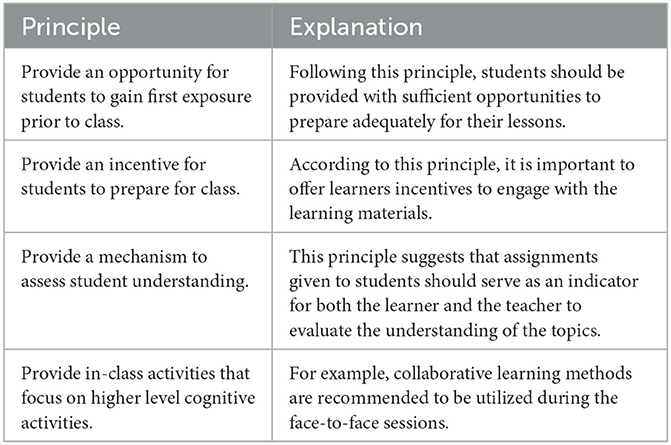
Table 1. Design principles for flipped classroom courses according to Brame (2013).
2.3. The flipped classroom method in physics and physics teacher education
Flipped classroom scenarios have already been widely implemented in physics and science courses at different educational levels in the past (cf. Deslauriers et al., 2011; Aşıksoy and Özdamlı, 2016). In order to examine the potential benefits of flipped courses in physics education, Christian et al. (2019) conducted a pre-post-test study with a total of 64 students divided into two groups. One group was instructed using a flipped approach, while the other received traditional instruction. Analysis of the results indicated that the students who were taught through the flipped classroom approach demonstrated significantly better performance than their counterparts who received traditional instruction. Sengel (2014) conducted a pre-post-test study to investigate the effectiveness of flipped courses in teaching physics topics to university students. The study revealed that students who were instructed using the flipped classroom approach outperformed their peers who received traditional instruction, despite initial difficulties with the new method. Additionally, an increased willingness to participate in the course was observed among the students of the flipped classroom group. Similar conclusions were drawn from additional research that examined the effectiveness of flipped and face-to-face classrooms in teaching science, in terms of both student perceptions and learning outcomes (cf. Aşıksoy and Özdamlı, 2016; Capone et al., 2017; Bawaneh and Moumene, 2020; Stratton et al., 2020; Aidoo et al., 2022a; Fung et al., 2022; Zeitoun et al., 2023).
2.4. Research rationale
The use of flipped classroom scenarios in physics teacher education is an emerging trend, with educators exploring their potential benefits as we have shown in the above sections. However, there is a lack of empirical evidence regarding their effectiveness in meeting students' expectations. This research aims to analyze whether a flipped classroom physics education course developed alongside design principles from the literature (see Section 2.2) can meet students' expectations in physics teacher education. The concept presented in this article (see Section 3), which considers students' needs and expectations extracted from an exploratory study (details on this pre-study are given in Section 3.2), seems promising with regards to enhancing the learning experience of physics pre-service teachers. The empirical evaluation of the implemented flipped classroom concept presented from Section 4 onwards is intended to reveal strengths and weaknesses. Hence, this research will contribute to the development of effective flipped classroom scenarios in physics teacher education that meet students' expectations and enhance their learning experience.
3. Design of a pre-service teachers' physics education course using flipped classroom
In this section, we locate the flipped physics education course described in this paper within the education context of physics teacher educational at Leipzig University, Germany (see Section 3.1). Then we report results of an exploratory pre-study which we conducted to collect pre-service physics teachers' expectations of and needs for physics education courses (see Section 3.2). Taken together the students' expectations and needs on the one hand, and the design principles for flipped classroom courses from the literature on the other hand (see Section 2.2), we derived key ideas for the development of our flipped classroom course on physics education which we describe in Section 3.3.
3.1. Educational context
The Standing Conference of the Ministers of Education and Cultural Affairs of the Länder in Germany established guidelines for teacher education by specifying content requirements for subject disciplines and subject matter didactics (Kultusministerkonferenz, 2019). These guidelines consist of standards that must be met by teacher education programs in Germany, which is composed of three phases taking place in various educational institutions. During the initial phase of teacher education, students acquire competences related to subject disciplines, working methods, and subject matter didactics (Kultusministerkonferenz, 2019, p. 3) through their university studies.
The flipped classroom course on physics education presented in this paper is situated within this first phase of teacher education. More specifically, it is designed for fifth semester students. The introductory physics education course at Leipzig University is scheduled after students' have been introduced to experimental physics on mechanics, electrodynamics, thermodynamics, optics, quantum optics and atomic physics as well as theoretical mechanics in semesters one to four. During the first four semesters, the students additionally participate in typical laboratory courses.
3.2. Collection of pre-service teachers' expectations of and needs for an introductory physics education course—A pre-study
Prior to course development, we explored pre-service teachers' expectations of and needs for their physics education courses in an exploratory manner. In this sub-section, we report the design and results of this exploratory study. The results of this pre-study informed the formulation of design principles underlying course development.
3.2.1. Study design, research question, and sample
We conducted an exploratory questionnaire study to answer the following research question: What are the needs and expectations of pre-service teachers regarding an introductory physics education course within their academic program?
Informations on the instrument used are given in Section 3.2.2. A total of 21 students enrolled in the physics teacher education program at Leipzig University responded to the questionnaire. None of the respondents had taken part in a physics education course prior to participating in this pre-study.
3.2.2. Instrument
The questionnaire consisted of two open-ended questions. The first question was used to collect students' expectations of the introductory physics education course, while the second question was devoted to gathering students' needs for this course. The questionnaire was implemented using the online tool SoSci Survey (https://www.soscisurvey.de/) and was password protected. Target group students were given access to the questionnaire during a limited time window of 5 days and participation was possible only once.
3.2.3. Data analysis
Qualitative content analysis was used to analyze the data (Mayring, 2004). Students' full-text responses were inductively categorized by two independent raters, with any discrepancies being resolved through discussion until complete agreement was reached. Duplicate occurrences of a specific category in a participant's response are excluded from the coding process as they do not contribute new insights into the participant's expectations or needs, and hence, may be redundant (cf. Bitzenbauer and Meyn, 2021). Lastly, frequency analysis was applied to determine the occurrence of the respective categories.
3.2.4. Results
Based on the students' answers to the first question on students' expectations of the introductory physics education course, seven categories were formed. In Table 2, the categories are summarized alongside anchor examples and the number of occurrences among the 21 respondents. The results of the analysis show that the students have various expectations of the introductory physics education course. On the one hand, they expect solid theoretical foundations and fundamental concepts of physics education (12 occurrences), and on the other hand, they also have expectations with regards to practical application of the acquired knowledge. For example, they want to learn about instructional sequences for teaching physics concepts (9 occurrences) and would like to apply their theoretical knowledge immediately through exercises or similar means (3 occurrences). Additionally, some students express interest in promoting students' interest and motivation in physics education (3 occurrences) and in getting to know students' learning difficulties in physics and how to address them (2 occurrences). Finally, a few students expect to learn how to create specific teaching materials for physics instruction and what tools are available for this purpose (2 occurrences).
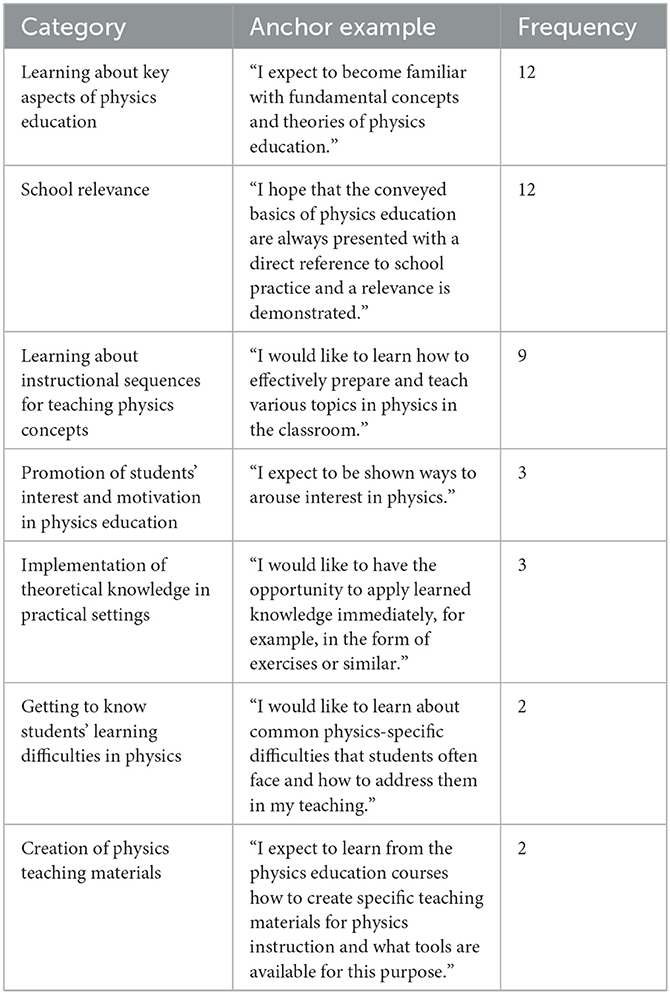
Table 2. Students' expectations of their introductory physics education course alongside anchor examples (freely translated from German) and the number of occurrences.
Based on the students' answers to the second question on students' needs for the introductory physics education course, another eight categories were formed. In Table 3, the categories are summarized alongside anchor examples and the number of occurrences among the 21 respondents. The results of the analysis of students' needs for the introductory physics education course show that students have both general needs, such as a good working atmosphere and accessibility of lecturers, as well as needs that are strongly connected to physics education, such as school relevance and exam preparation. Interestingly, some categories of needs, such as school relevance, are similar to categories found in the expectations table. This indicates that students have (a) clear expectations of the course and (b) a clear idea of what they need to succeed. Based on these findings, along with design principles from the literature, we developed a flipped classroom course on physics education, which will be described in the next Section 3.3.
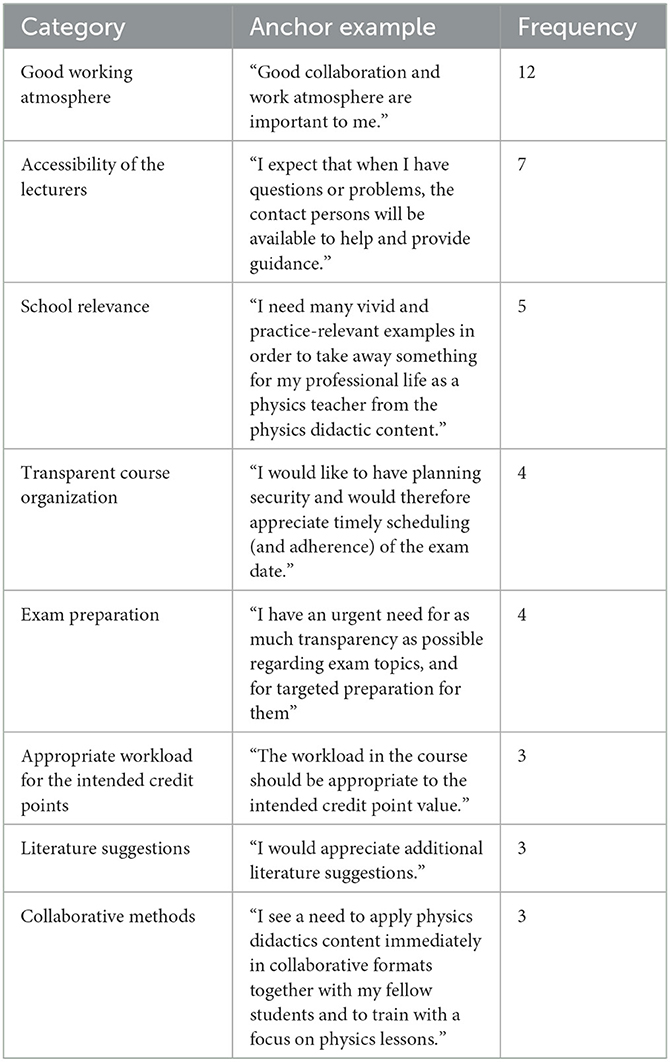
Table 3. Students' needs for their introductory physics education course alongside anchor examples (freely translated from German) and the number of occurrences.
3.3. Description of the course and the implementation of the design principles
The course is organized around a Flipped Classroom concept, where students learn about fundamental topics of physics education through interactive digital learning resources called LearningBits (e.g., interactive h5p videos, quizzes etc.), which they access through an online course (cf. Küsel and Markic, 2021). The LearningBits enable students to prepare for the in-person sessions and provide transparent competence expectations. The analog in-person sessions provide an opportunity for students to deepen their understanding through discussion and analysis of preparation tasks. The sessions also analyze practical examples, such as the handling of preconceptions in physics education and experimentation situations, through reflection on theoretical insights. To assist students with any questions, a Helpdesk is offered as an online session each week. The implementation of the design principles by Kim et al. (2014) in our introductory flipped classroom physics education course is detailed in Table 4.
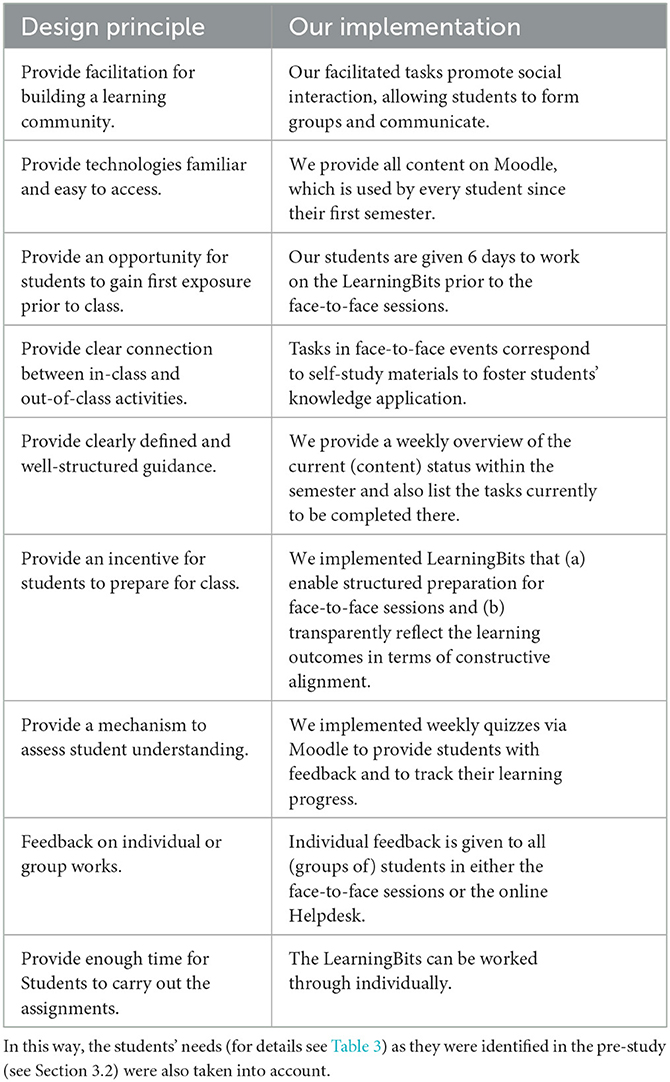
Table 4. Implementation of the design principles according to Kim et al. (2014) in the development of our introductory physics education course in the flipped classroom format implemented at Leipzig University, Germany.
The students' voiced expectations of the introductory physics education course above all refer to content aspects (for details see Table 2). Hence, to meet these students' expectations we in particular ensure to allow for a transfer of theoretical foundations of physics education to school practice through different methods in the face-to-face settings such as analyzing and reflecting on specific cases from classroom practice (e.g., using communication protocols), implementing role plays or discussion tasks. In terms of content, the following topics are covered in the course: (1) Surface and deep structure of physics lessons, (2) Student conceptions and conceptual change, (3) Model of Educational Reconstruction, (4) The role of language in physics teaching, (5) Models in physics education, (6) Experiments in physics education, (7) Nature of Science in physics education, (8) The role of mathematics in physics education, (9) Interest and motivation, (10) Heterogeneity in physics classrooms, (11) Scientific Literacy and competence orientation, (12) Tasks in physics education, (13) Reflection of physics lessons, (14) Assessment. Advanced physics education courses offered as a part of the physics teacher education program at Leipzig University provide an opportunity for students to further develop their understanding beyond the fundamental concepts covered in the course presented here. Interested readers can get access to our course from the corresponding author.
4. Research questions
In the context of accompanying evaluation of the flipped classroom physics education course presented in this article, the following research questions were investigated:
1. To what extent can the students' needs and expectations identified in Section 3.2 be met with the flipped classroom physics education course presented in this article (developed based on design criteria from the literature)?
2. How do students perceive the implemented flipped classroom concept in terms of…
(a) …organizational, affective or cognitive aspects of learning,
(b) …the participation and support of the students, and
(c) …the quality of the self-study materials?
5. Methods
5.1. Study design and sample
The flipped classroom physics education course presented in this paper was implemented at Leipzig University in the winter term 2022/23. We conducted a questionnaire study at the end of the winter term to evaluate the course with a view to the research questions. The data collection took place in February 2023.
Participation in the study was voluntary. Out of the total 38 students who had registered for the course, 28 completed the questionnaire in its entirety while 29 started.
5.2. Instrument
The questionnaire consisted of different blocks, each addressing a different aspect of the research questions. The following paragraphs provide a brief overview of these blocks.
5.2.1. Students' needs and expectations
The pre-service physics teachers' needs for and expectations of the introductory physics education course, which were identified in Section 3.2, were first summarized (i.e., categorized, for details see Tables 2, 3) and then re-phrased as statements. In the first item battery, the students were then asked to rate their level of agreement with these statements on a rating scale ranging from 1 (corresponding to “strongly disagree”) to 4 (corresponding to “strongly agree”). The items are shown in Tables 5, 6 alongside a description of the answer patterns.

Table 5. Students' responses to the implementation of students' needs as identified in the pre-study (see Table 3). The absolute frequencies for the occurrence of the rating options are given.
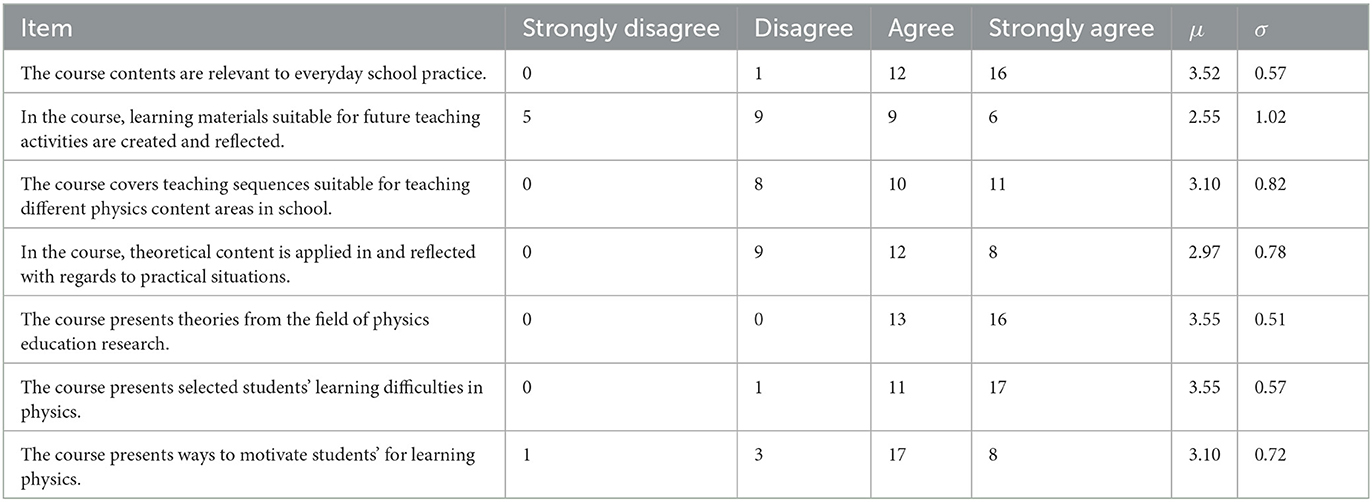
Table 6. Students' responses to the fulfillment of students' expectations as identified in the pre-study (see Table 2). The absolute frequencies for the occurrence of the rating options are given.
5.2.2. Student perceptions of the flipped classroom course
We assessed the impact of our flipped course on student learning using 18 single-choice items (agree/disagree) adapted from a questionnaire developed in the INKULT project (ILI, 2022). These items evaluated organizational, affective, and cognitive aspects of learning. The items are provided in Table 8. Cronbach's Alpha as an estimator of the internal consistency of the scale has been found to be α = 0.77 in our study.
In addition, we used rating-scale items (with a four-point scale where 1 corresponds to “strongly disagree” and 4 corresponds to “strongly agree”) which (a) have been developed and validated by Valero et al. (2019) and that (b) have been used in earlier studies on flipped classroom environments (e.g., see Ruslan et al., 2022):
• Five items on affective and cognitive aspects of student learning. Cronbach's Alpha as an estimator of the internal consistency of the scale has been found to be α = 0.82 in our study. The items of the scale are given in Table 7.
• Four items on student participation and support in the course. Cronbach's Alpha as an estimator of the internal consistency of the scale has been found to be α = 0.78 in our study. The items of the scale are given in Table 9.
• Seven items on the quality of the self-study materials. Cronbach's Alpha as an estimator of the internal consistency of the scale has been found to be α = 0.82 in our study. The items of the scale are given in Table 10.

Table 7. Students' ratings regarding items on the impact of the flipped classroom physics education on affective and cognitive aspects of their learning. The absolute frequencies for the occurrence of the rating options are given.
5.3. Data analysis
The responses of the students were initially analyzed using frequency analysis. As descriptive statistics, we report the mean value μ and the standard deviation σ for each item and for the scale scores. Diverging Stacked Bar Charts (Robbins and Heiberger, 2011) summarize the results of evaluating each statement on a scale by displaying a normalized bar aligned relative to the center of the scale. The percentage of participants who (rather) agree with a statement is shown on the right side of the scale, while the percentage of study participants who (rather) disagree with a statement is read on the left side of the scale. A shift of the entire bar to the right indicates a tendency toward agreement of the respondents to a given statement, while a shift to the left indicates a tendency toward disagreement.
6. Results
6.1. Results regarding research question 1: students' needs and expectations
6.1.1. Are students' needs met?
Table 5 presents the results of a survey conducted among students to measure the implementation of their identified needs. Looking at the mean scores for each item, it seems that students generally had a positive response to the implementation of their identified needs in the pre-study. The highest mean scores were for timely contact with module coordinators, implementation of various methods for sustainable learning during in-person sessions, and clear organization of the module. However, there were also some areas for improvement, such as providing sufficient materials or literature recommendations for exam preparation and making exam expectations more transparent.
It is noteworthy that the standard deviations for the mean scores were generally low, indicating that the responses were relatively consistent across the student population. However, there were a few items (e.g., “The workload fits well to the intended workload”) where some students (strongly) disagreed while others agreed (completely), suggesting that this aspect of the module may be more polarizing among students.
6.1.2. Are students' expectations met?
The results in the Table 6 show that the students were mostly satisfied with the course in terms of meeting their expectations. The items related to presenting theories from the field of physics education research, presenting selected students' learning difficulties in physics, and the on course contents being relevant to everyday school practice received the highest levels of agreement, with means above 3.5 on a 4-point rating scale. The items related to creating and reflecting on teaching materials, covering teaching sequences for different physics content areas, and applying theoretical content in practical situations received lower levels of agreement, but still had means above 2.5.
6.2. Results regarding research question 2: student perceptions of the flipped classroom course
6.2.1. Results regarding research question 2a: impact on organizational, affective, and cognitive aspects of learning
Table 7 presents students' ratings regarding the impact of the flipped classroom approach on affective and cognitive aspects of their learning. The results suggest that, on average, students agreed or strongly agreed with the statements that the flipped classroom approach helped them to learn and understand the course content (μ = 2.57, σ = 0.73) and found the approach intellectually challenging and stimulating (μ = 2.61, σ = 0.82). However, the results also indicate that, on average, students were slightly less enthusiastic about the impact of the flipped classroom on their motivation and interest in the subject, with mean ratings of 2.29 (σ = 0.70) and 2.36 (σ = 0.89), respectively. A graphical overview of these results is provided in Figure 1.

Figure 1. Diverging Stacked Bar Chart on students' ratings regarding items on affective and cognitive aspects of their learning experience.
The results presented in Table 8 shed some more light on the student perceptions: Again, the majority of the students agreed that the flipped classroom approach helped them to prepare for synchronous face-to-face sessions (15 agree vs. 14 disagree), work on the course content at their own pace (14 agree vs. 15 disagree), and know what to expect in the exam (14 agree vs. 15 disagree) as is shown in Table 8. However, there were several areas where the students did not find the flipped classroom approach to be particularly helpful. For example, a majority of the students disagreed that the flipped classroom approach helped them to structure their learning (3 agree vs. 26 disagree), stay continuously motivated throughout the semester (3 agree vs. 26 disagree), and receive additional support for their studies (5 agree vs. 24 disagree).
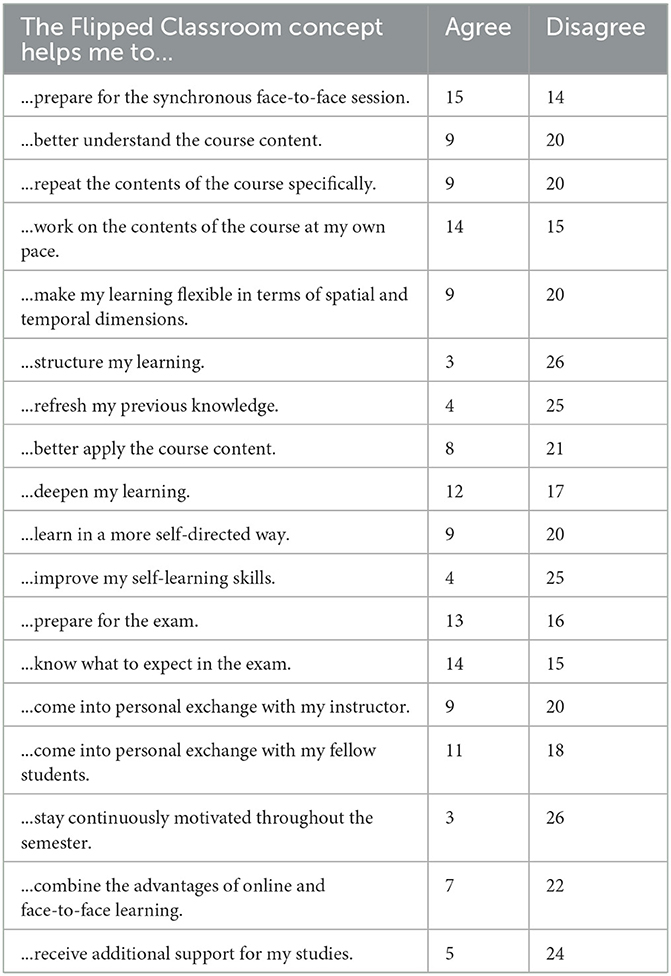
Table 8. Student perceptions of organizational, affective, and cognitive aspects of the flipped classroom physics education course under investigation. The absolute frequencies for the occurrence of the rating options are given.
6.2.2. Results regarding research question 2b: student participation and support
Table 9 provides the results of the items in which students were asked to rate their agreement with four statements related to their involvement and participation in face-to-face sessions as well as the perceived support. The results indicate that the majority of students agreed that they were encouraged to participate in class discussions, share their ideas and knowledge, express their own ideas and question the instructor. The mean scores for these items were high, ranging from 3.43 to 3.61, with standard deviations ranging from 0.49 to 0.68. These findings suggest that the students generally perceived a high level of encouragement and support for their participation in the flipped classroom concept under investigation. A graphical overview of these results is provided in Figure 2.

Table 9. Student perceptions of the impact of the flipped classroom physics education course presented in this article on learner participation and support. The absolute frequencies for the occurrence of the rating options are given.
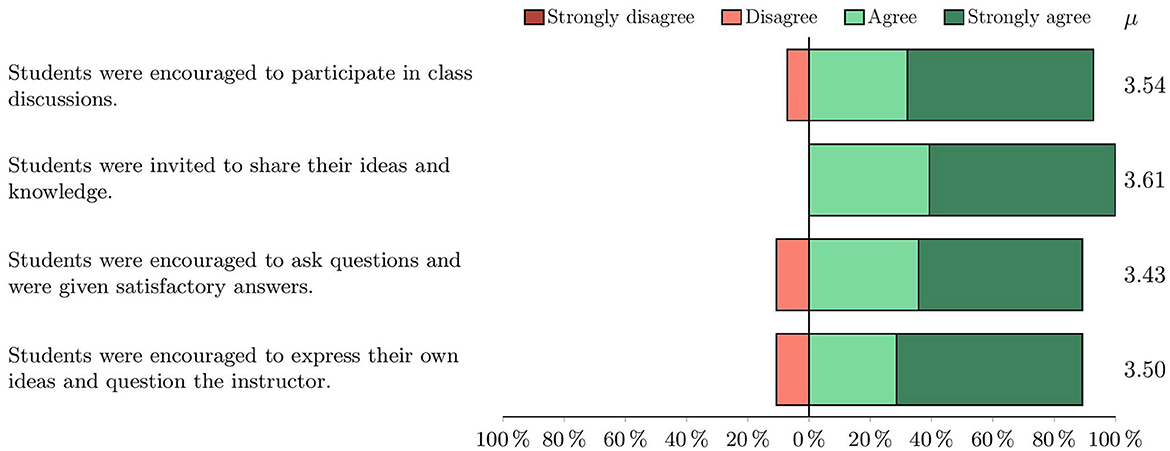
Figure 2. Diverging Stacked Bar Chart on students' ratings regarding items on the impact of the flipped classroom physics education course presented in this article on learner participation and support.
6.2.3. Results regarding research question 2c: quality of learning materials
We gathered students' perceptions of the learning materials used in the self-study phase of the course. The results (see Table 10) indicated that the majority of students found the materials to be helpful in preparing for face-to-face sessions and were able to comprehend the content through watching videos or reading texts prior to class. Despite the self-reported value of the self-study materials, some students reported that they did not have enough time to view the videos—which seems surprising since the majority of the students stated that the time for preparation was appropriate. This finding may have implications for educators and instructional designers who are considering implementing a flipped classroom approach, as they may need to provide additional guidance on time management strategies to optimize the effectiveness of self-study materials. A graphical overview of these results is provided in Figure 3.
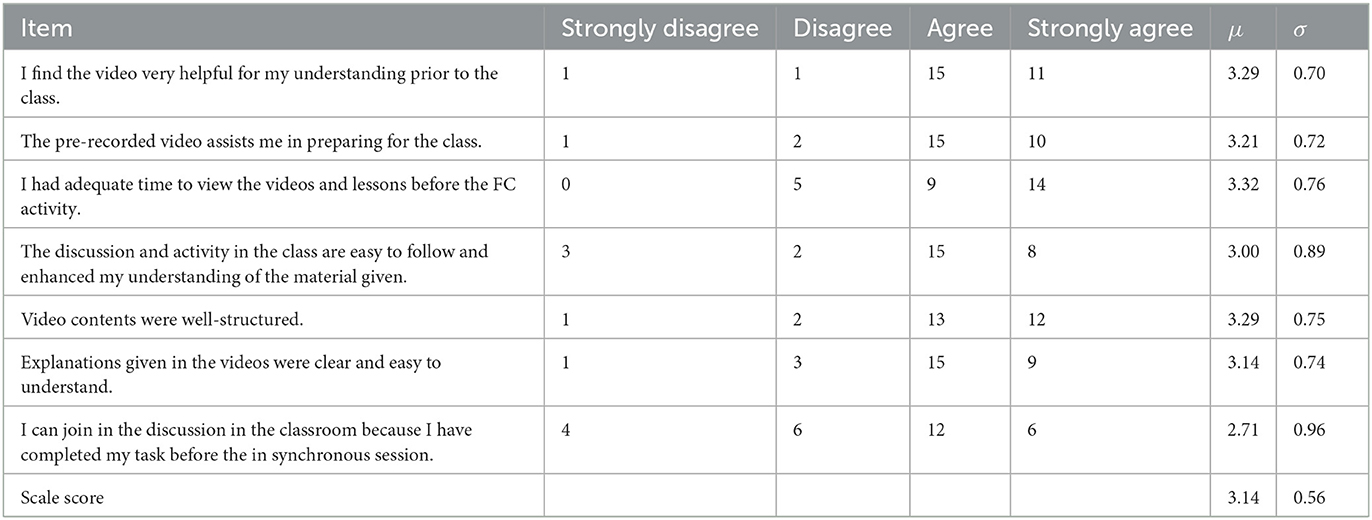
Table 10. Student assessment of the quality of the learning materials provided for the self-study phase. The absolute frequencies for the occurrence of the rating options are given.
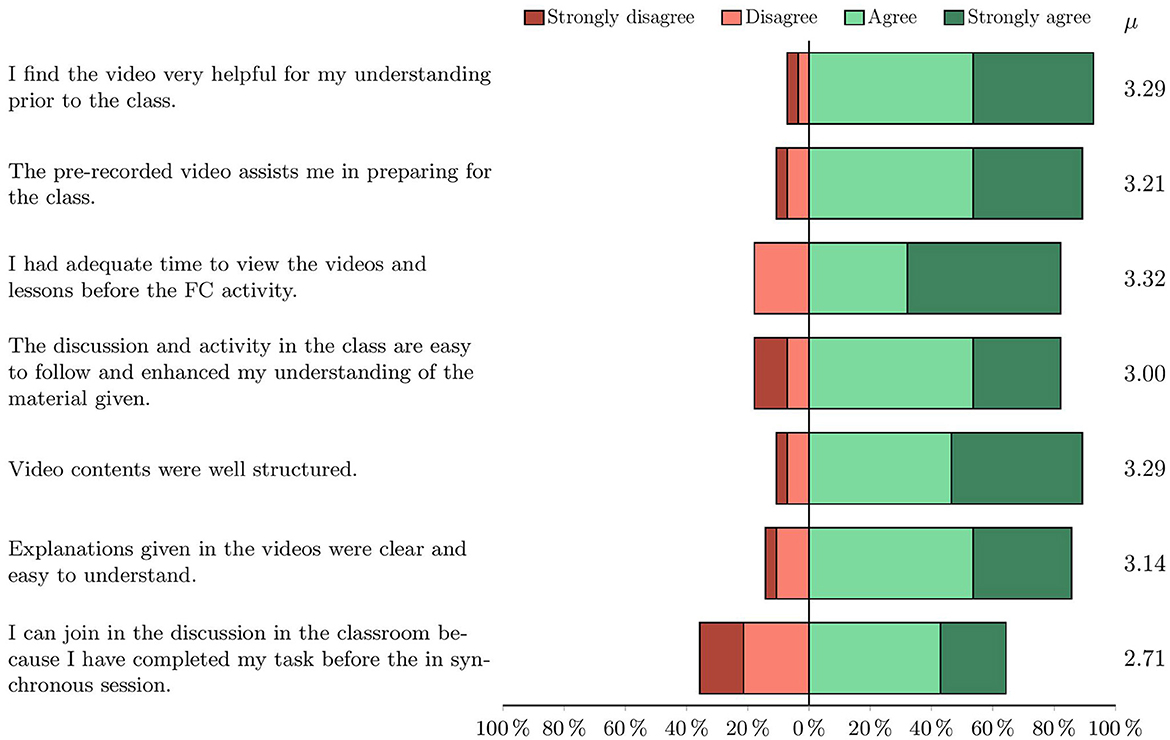
Figure 3. Diverging Stacked Bar Chart on students' ratings regarding items on the quality of the learning materials provided for the self-study phase.
7. Discussion
The implementation of flipped classroom approaches has gained increasing attention in recent years, particularly in the field of education. In this study, we aimed to design a flipped classroom concept that could enhance physics teacher education, taking into consideration relevant literature and the needs and expectations of students. Our research focused on the empirical evaluation of the developed flipped classroom approach, providing insights into its strengths and weaknesses. The findings of our study have important implications for the use of flipped classroom scenarios in physics teacher education, and point toward further avenues of research in this area.
The evaluation of our flipped classroom physics education course yielded several findings that are consistent with previous research (cf. Doo, 2021; Aidoo et al., 2022b): Out of the 29 students participating in our questionnaire study at the end of course implementation…
• …15 students state that the flipped approach is useful for the preparation of face-to-face discussions. This aligns with the conclusions of Alvarez (2012) and Fulton (2012).
• …9 students report that the flipped classroom helps to organize their learning independent from spatial and temporal boundary conditions, which was also shown by O'Flaherty and Phillips (2015). Similarly, 14 students state that our flipped classroom approach allows them to elaborate on the course contents in their own pace which has already been found for flipped classroom concepts in different contexts before (e.g., see Nouri, 2016; Zainuddin and Halili, 2016). In contrast, however, only three of our study participants state that the flipped classroom concept would have had an impact on organizing one's own learning process. We argue that this might be due to difficulties in students' self-regulation and self-instruction which is in parallel with earlier findings published by Hwang et al. (2015) or Hyppönen et al. (2019).
• …13 students state that the flipped classroom helps with exam preparation and 14 students stated that the approach was useful in becoming familiar with the exam requirements. This agrees with earlier studies, such as by Gross et al. (2015) or O'Flaherty and Phillips (2015), which showed that students in flipped environments might outperform students who had participated in traditional instruction before.
• …11 students attest that the flipped environment would benefit the building of learning communities which is considered a relevant aspect of flipped classroom scenarios (Kim et al., 2014).
Taken together, this study—in the context in a physics education course as part of physics teacher education—underpins earlier findings according to which the flipped classroom may have a positive influence on students' learning behavior and (self-reported) performance. However, the study also reveals that some students may prefer a traditional lecture with fewer self-activities during face-to-face events (see in particular students' ratings in Table 8). From the results of this study, we propose three key recommendations that instructors or trainers may want to consider when developing a flipped classroom scenario:
1. We recommend that the development of flipped classroom concepts be based on well-defined design principles (form the literature) from the very beginning. In this study, we followed (Kim et al., 2014) to ensure that the various quality criteria were taken into account in the development of our physics education course. In addition, we have shown how the inclusion of student needs and expectations can be realized with little additional effort. We believe that the latter might contribute to increase the students' sense of being involved into to course progress. The results from Table 9 on learners' participation and support underline this hypothesis, but of course do not allow us to draw causal conclusions.
2. In addition, we suggest focusing on an clear connection between (potential) video content in the self-study phase and the tasks provided in-class activities to improve the students' learning experience. In our case, a lack of such a clear connection between self-study phase and face-to-face scenario was identified as a striking obstacle for learners (see Section 6.2.3).
3. Lastly, we recommend educators and instructors to provide guidance on time management strategies in flipped classroom scenarios in order to optimize their effectiveness (see results in Section 6.2.3). Similarly, earlier research underlines that this “might be even more important in a flipped classroom since self-regulation skills and self-discipline become more important than traditional lectures” (Nielsen, 2023, p. 15).
We believe the above recommendations might be valuable whenever it comes to developing a flipped classroom environment, even though this study analyzes a specific physics education course as part of physics teacher education. We address the limitations of this research in Section 8.1.
8. Limitations and outlook
8.1. Limitations
The findings presented in this article can inform the design and development of future flipped classroom courses to better meet the needs and expectations of students (see recommendations provided in Section 7). However, it is important to note that the study was conducted in the context of a physics education course, and further research is needed to determine the generalizability of these findings to other subjects and disciplines. Additionally, future research could explore the specific teaching strategies that instructors can use to foster student participation and support in the flipped classroom in general, and with regards to physics education courses in particular.
It is worth noting that while the sample size in this study is relatively small, the data provides useful insights into how students perceive the course and how it could be improved in the future. To generalize these findings to a larger population, further research with larger sample sizes is needed. Additionally, it may be helpful to gather qualitative data, for example from interviews or focus group discussions, to gain a deeper understanding of students' perspectives.
8.2. Outlook
To prepare future physics teachers for the challenges of teaching, a comprehensive didactic education in physics, closely connected with high-quality subject-specific training, is essential. Enriched learning, which includes reflection on experiences, particularly those related to teaching practice, is likely to be beneficial for students' professional development. Studies have shown that promoting professional competencies in courses using a flipped classroom approach might be more favorable than traditional teaching formats since the flipped classroom's internal organizational structure creates a concrete link between knowledge acquisition, application, and transfer (Abeysekera and Dawson, 2015).
Therefore, we developed and evaluated a flipped classroom physics education course that serves as an introductory course in physics didactics for prospective physics teachers in their fifth semester of study at the University of Leipzig. Currently, we are establishing a teaching-learning laboratory at the University of Leipzig, called DigiSpace, to provide students with the opportunity to apply their knowledge of physics didactics under conditions of reduced complexity in a protected framework for planning shorter teaching sequences: The DigiSpace mainly focuses on teaching and learning physics with the help of digital tools (https://www.physgeo.uni-leipzig.de/dip/digi-space). In an advanced physics education course based on the flipped classroom course presented in this article, students will design an explanatory sequence on a certain physics topic using a selected digital tool for a given target group. They will test this explanatory sequence through microteaching directly in the DigiSpace. The DigiSpace's equipment (e.g., a 360° camera), allows for subsequent reflection on the explanatory sequence and the pre-service teacher's actions. By doing so, the contents of the introductory physics education course presented in this article are taken up, and will be even more strongly connected to the teaching practice of the prospective physics teachers. In the future, we will report on the results of the evaluation of courses in the DigiSpace.
Data availability statement
The raw data supporting the conclusions of this article will be made available by the authors, without undue reservation.
Ethics statement
Ethical review and approval was not required for the study on human participants in accordance with the local legislation and institutional requirements. The patients/participants provided their written informed consent to participate in this study.
Author contributions
PB: conceptualization, methodology, investigation, data curation, writing—original draft, writing–review and editing, and supervision. FH: formal analysis, writing—original draft, and writing–review and editing. All authors contributed to the article and approved the submitted version.
Funding
The authors acknowledge support from the German Research Foundation (DFG) and Universität Leipzig within the program of Open Access Publishing.
Conflict of interest
The authors declare that the research was conducted in the absence of any commercial or financial relationships that could be construed as a potential conflict of interest.
Publisher's note
All claims expressed in this article are solely those of the authors and do not necessarily represent those of their affiliated organizations, or those of the publisher, the editors and the reviewers. Any product that may be evaluated in this article, or claim that may be made by its manufacturer, is not guaranteed or endorsed by the publisher.
References
Abeysekera, L., and Dawson, P. (2015). Motivation and cognitive load in the flipped classroom: definition, rationale and a call for research. Higher Educ. Res. Dev. 34, 1–14. doi: 10.1080/07294360.2014.934336
Aidoo, B., Anthony-Krueger, C., Gyampoh, A. O. G., Tsyawo, J., and Quansah, F. (2022a). A mixed-method approach to investigate the effect of flipped inquiry-based learning on chemistry students learning. Eur. J. Sci. Math. Educ. 10, 507–518. doi: 10.30935/scimath/12339
Aidoo, B., Vesterinen, V.-M., MacDonald, M. A., Gísladóttir, B., and Pétursdóttir, S. (2022b). Perceptions of Ghanaian student teachers on benefits and challenges of the flipped classroom: a case study. Contemp. Educ. Technol. 14, ep377. doi: 10.30935/cedtech/12163
Alvarez, B. (2012). Flipping the classroom: homework in class, lessons at home. Educ. Digest 77, 18.
Aşıksoy, G., and Özdamlı, F. (2016). Flipped classroom adapted to the arcs model of motivation and applied to a physics course. Eur. J. Math. Sci. Technol. Educ. 12, 1589–1603. doi: 10.12973/eurasia.2016.1251a
Bawaneh, A. K., and Moumene, A. B. H. (2020). Flipping the classroom for optimizing undergraduate students' motivation and understanding of medical physics concepts. Eur. J. Math. Sci. Technol. Educ. 16. doi: 10.29333/ejmste/8561
Bishop, J., and Verleger, M. (2013). “The flipped classroom: a survey of the research,” in 120th ASEE Annual Conference and Exposition, Conference Proceedings (Atlanta), 6219.
Bitzenbauer, P., and Meyn, J.-P. (2021). Fostering students' conceptions about the quantum world–results of an interview study. Prog. Sci. Educ. 4, 40–51. doi: 10.25321/prise.2021.1079
Boeve, A., Meijer, R., Bosker, R., Vugteveen, J., Hoekstra, R., and Albers, C. (2017). Implementing the flipped classroom: an exploration of study behaviour and student performance. Higher Educ. 74, 1015–1032. doi: 10.1007/s10734-016-0104-y
Brame, C. (2013). Flipping the classroom. Available online at: https://cft.vanderbilt.edu/guides-sub-pages/flipping-the-classroom/
Buerck, J. P., Malmstrom, T. K., and Peppers, E. (2003). Learning environments and learning styles: non-traditional student enrollment and success in an internet-based versus a lecture-based computer science course. Learn. Environ. Res. 6, 137–155. doi: 10.1023/A:1024939002433
Capone, R., Del Sorbo, M. R., and Fiore, O. (2017). A flipped experience in physics education using clil methodology. Eur. J. Math. Sci. Technol. Educ. 13, 6579–6582. doi: 10.12973/ejmste/77044
Christian, S., Chukwuebuka, C., Gana, C., Chinyere, A., Catherine, U., Ene, A., et al. (2019). “Effectiveness of flipped classroom instructional technology model in enhancing students' achievement in physics,” in International Journal of u-and e-Service, Science and Technology, 37–46.
Dean, D., Davies, R., and Ball, N. (2013). Flipping the classroom and instructional technology integration in a college-level information systems spreadsheet course. Educ. Technol. Res. Dev. 61, 563–580. doi: 10.1007/s11423-013-9305-6
Deslauriers, L., Schelew, E., and Wieman, C. (2011). Improved learning in a large-enrollment physics class. Science 332, 862–864. doi: 10.1126/science.1201783
Doo, M. Y. (2021). Understanding flipped learners' perceptions, perceived usefulness, registration intention, and learning engagement. Contemp. Educ. Technol. 14, ep331. doi: 10.30935/cedtech/11368
Elen, J., and Clarebout, G. (2001). An invasion in the classroom: influence of an ill-structured innovation on instructional and epistemological beliefs. Learn. Environ. Res. 4, 87–105. doi: 10.1023/A:1011450524504
Fidan, M. (2023). The effects of microlearning-supported flipped classroom on pre-service teachers' learning performance, motivation and engagement. Educ. Inform. Technol. 1–28. doi: 10.1007/s10639-023-11639-2
Finkenberg, F. E., and Trefzger, T. (2019). Flipped classroom in secondary school physics education. J. Phys. Conf. Ser. 1286, 012015. doi: 10.1088/1742-6596/1286/1/012015
Fischer, M., and Spannagel, C. (2012). “Lernen mit Vorlesungsvideos in der umgedrehten Mathematikvorlesung,” In Die 10. e-Learning Fachtagung Informatik der Gesellschaft fur Informatik e.V., eds J. Desel, J. M. Haake, and C. Spannagel (Bonn), 225–236.
Foertsch, J., Moses, G., Strikwerda, J., and Litzkow, M. (2002). Reversing the lecture/homework paradigm using eTEACH? web-based streaming video software. J. Eng. Educ. 91, 267–274. doi: 10.1002/j.2168-9830.2002.tb00703.x
Foldnes, N. (2016). The flipped classroom and cooperative learning: evidence from a randomised experiment. Act. Learn. Higher Educ. 17, 39–49. doi: 10.1177/1469787415616726
Foreman, J. E. (2003). Next-generation educational technology versus the lecture. Educ. Rev. 38, 12–16.
Fredriksen, H. (2021). Exploring realistic mathematics education in a flipped classroom context at the tertiary level. Int. J. Sci. Math. Educ. 19, 377–396. doi: 10.1007/s10763-020-10065-x
Fulton, K. P. (2012). 10 reasons to flip. Phi Delta Kappan 94, 20–24. doi: 10.1177/003172171209400205
Fung, C.-H., Poon, K.-K., and Ng, S.-P. (2022). Fostering student teachers' 21st century skills by using flipped learning by teaching in stem education. Eur. J. Math. Sci. Technol. Educ. 18, em2204. doi: 10.29333/ejmste/12728
Garrison, D., Anderson, T., and Archer, W. (1999). Critical inquiry in a text-based environment: computer conferencing in higher education. Internet Higher Educ. 2, 87–105.
Graham, C. R. (2006). “Blended learning systems: Definition, current trends, and future directions,” in The Handbook of Blended Learning: Global Perspectives, Local Designs, eds C. J. Bonk, and C. R. Graham (Zürich: Pfeiffer Publishing), 3–21.
Gross, D., Pietri, E. S., Anderson, G., Moyano-Camihort, K., and Graham, M. J. (2015). Increased preclass preparation underlies student outcome improvement in the flipped classroom. CBE Life Sci. Educ. 14, ar36. doi: 10.1187/cbe.15-02-0040
He, W., Holton, A., Farkas, G., and Warschauer, M. (2016). The effects of flipped instruction on out-of-class study time, exam performance, and student perceptions. Learn. Instruct. 45, 61–71. doi: 10.1016/j.learninstruc.2016.07.001
Hrastinski, S. (2019). What do we mean by blended learning? TechTrends 63, 564–569. doi: 10.1007/s11528-019-00375-5
Hwang, G.-J., Lai, C.-L., and Wang, S.-Y. (2015). Seamless flipped learning: a mobile technology-enhanced flipped classroom with effective learning strategies. J. Comput. Educ. 2, 449–473. doi: 10.1007/s40692-015-0043-0
Hyppönen, L., Hirsto, L., and Sointu, E. (2019). Perspectives on university students' self-regulated learning, task-avoidance, time management and achievement in a flipped classroom context. Int. J. Learn. Teach. Educ. Res. 18, 87–106. doi: 10.26803/ijlter.18.13.5
ILI (2022). Entwicklung und Erprobung von Flipped Classroom-Konzepten zur Verschränkung von digitaler und analoger Lehre als “New Normal” der Lehre an der FAU.
Kim, M., Kim, S. M., Khera, O., and Getman, J. (2014). The experience of three flipped classrooms in an urban university: An exploration of design principles. Internet Higher Educ. 22, 37–50. doi: 10.1016/j.iheduc.2014.04.003
Kulgemeyer, C., and Wittwer, J. (2022). Misconceptions in physics explainer videos and the illusion of understanding: an experimental study. Int. J. Sci. Math. Educ. 21, 417–437. doi: 10.1007/s10763-022-10265-7
Kultusministerkonferenz (2019). Ländergemeinsame inhaltliche Anforderungen für die Fachwissenschaften und Fachdidaktiken in der Lehrerbildung.
Kurup, V., and Hersey, D. (2012). The changing landscape of anesthesia education: is flipped classroom the answer? Curr. Opin. Anaesthesiol. 26, 726–731. doi: 10.1097/ACO.0000000000000004
Küsel, J., and Markic, S. (2021). Hochschullehre im flipped classroom mit interaktiven digitalen medien. Gesellschaft für Didaktik der Chemie und Physik 41, 573–576.
Lage, M. J., Platt, G. J., and Treglia, M. (2000). Inverting the classroom: a gateway to creating an inclusive learning environment. J. Econ. Educ. 31, 30–43. doi: 10.1080/00220480009596759
Lin, Y.-T. (2021). Effects of flipped learning approaches on students' learning performance in software engineering education. Sustainability 13. doi: 10.3390/su13179849
Mayring, P. (2004). “Qualitative content analysis,” in A Companion to Qualitative Research, eds U. Flick, E. von Kardoff, and I. Steinke (London: SAGE Publications), 159–176.
McNally, B., Chipperfield, J., Dorsett, P., Del Fabbro, L., Frommolt, V., Goetz, S., et al. (2017). Flipped classroom experiences: student preferences and flip strategy in a higher education context. High. Educ. 73, 281–298. doi: 10.1007/s10734-016-0014-z
Nielsen, K. L. (2023). Why can the flipped classroom frustrate students? experiences from an engineering mathematics course. Educ. Sci. 13, 396. doi: 10.3390/educsci13040396
Nouri, J. (2016). The flipped classroom: for active, effective and increased learning–especially for low achievers. Int. J. Educ. Technol. High. Educ. 13, 1–10. doi: 10.1186/s41239-016-0032-z
O'Flaherty, J., and Phillips, C. J. (2015). The use of flipped classrooms in higher education: a scoping review. Internet High. Educ. 25, 85–95. doi: 10.1016/j.iheduc.2015.02.002
Ozdamli, F., and Aşıksoy, G. (2016). Flipped classroom approach. World J. Educ. Technol. 8, 98. doi: 10.18844/wjet.v8i2.640
Prober, C. G., and Khan, S. (2013). Medical education reimagined: a call to action. Acad. Med. J. Assoc. Am. Med. Coll. 88, 1407–1410. doi: 10.1097/ACM.0b013e3182a368bd
Robbins, N. B., and Heiberger, R. M. (2011). “Plotting likert and other rating scales,” in Proceedings of the 2011 Joint Statistical Meeting (American Statistical Association).
Ruiz, C. G. (2021). The effect of integrating kahoot! and peer instruction in the Spanish flipped classroom: the student perspective. J. Spanish Lang. Teach. 8, 63–78. doi: 10.1080/23247797.2021.1913832
Ruslan, M. S. H., Sapiee, N. H., Kurnia, K. A., Amran, N. A., and Abd Rahman, N. (2022). Student adoption and effectiveness of flipped classroom implementation for process simulation class. Educ. Sci. 12, 763. doi: 10.3390/educsci12110763
Sams, A., and Bergmann, J. (2012). Flip Your Classroom: Reach Every Student in Every Class Every Day. International Society for Technology in Education.
Sangermán Jiménez, M. A., Ponce, P., and Vázquez-Cano, E. (2021). Youtube videos in the virtual flipped classroom model using brain signals and facial expressions. Future Internet 13, 224. doi: 10.3390/fi13090224
Schwichow, M. (2021). “Kompetenzorientierte Lehre in physikdidaktischen Lehrveranstaltungen nach dem Inverted-Classroom-Ansatz,” in Lehrkräftebildung neu gedacht- Ein Praxishandbuch für die Lehre in den Naturwissenschaften und deren Didaktiken, eds M. Kubusch, S. Sorge, J. Arnold, and N. Graulich (Münster: Waxmann) 40–44.
Sengel, E. (2014). Using the “flipped classroom” to enhance physics achievement of the prospective teacher impact of flipped classroom model on physics course. J. Balkan Tribol. Assoc. 20, 488–497.
Shea, P., and Bidjerano, T. (2010). Learning presence: towards a theory of self-efficacy, self-regulation, and the development of a communities of inquiry in online and blended learning environments. Comput. Educ. 55, 1721–1731. doi: 10.1016/j.compedu.2010.07.017
Shea, P., Hayes, S., Smith, S., Vickers, J., Bidjerano, T., Pickett, A., et al. (2012). Learning presence: additional research on a new conceptual element within the community of inquiry (COI) framework. Internet High. Educ. 15, 89–95. doi: 10.1016/j.iheduc.2011.08.002
Stratton, E., Chitiyo, G., Mathende, A. M., and Davis, K. M. (2020). Evaluating flipped versus face-to-face classrooms in middle school on science achievement and student perceptions. Contemp. Educ. Technol. 11, 131–142. doi: 10.30935/cet.646888
Strayer, J. (2012). How learning in an inverted classroom influences cooperation, innovation and task orientation. Learn. Environ. Res. 15, 171–193. doi: 10.1007/s10984-012-9108-4
Strelan, P., Osborn, A. J., and Palmer, E. K. (2020). The flipped classroom: a meta-analysis of effects on student performance across disciplines and education levels. Educ. Res. Rev. 30, 100314. doi: 10.1016/j.edurev.2020.100314
Suárez, F., Mosquera Feijóo, J. C., Chiyón, I., and Alberti, M. G. (2021). Flipped learning in engineering modules is more than watching videos: the development of personal and professional skills. Sustainability 13, 12290. doi: 10.3390/su132112290
Swan, K., Matthews, D., Bogle, L., Boles, E., and Day, S. (2012). Linking online course design and implementation to learning outcomes: A design experiment. Internet High. Educ. 15, 81–88. doi: 10.1016/j.iheduc.2011.07.002
Talbert, R. (2017). Flipped Learning: A Guide for Higher Education Faculty. Sterling, VA: Stylus Publishing, LLC.
Valero, M., Martinez, M., Pozo, F., and Planas, E. (2019). A successful experience with the flipped classroom in the transport phenomena course. Educ. Chem. Eng. 26, 67–79. doi: 10.1016/j.ece.2018.08.003
Weiß, L.-F., and Friege, G. (2021). The flipped classroom: media hype or empirically based effectiveness? Prob. Educ. 21st Century 79, 312–332. doi: 10.33225/pec/21.79.312
Werner, J., Ebel, C., and Spannagel, C. (2018). Flipped Classroom–Zeit für deinen Unterricht. Praxisbeispiele, Erfahrungen und Handlungsempfehlungen [Flipped Classroom - Time for your lessons. Practical examples, experiences and recommendations for action]. Bertelsmann Stiftung.
Zainuddin, Z., and Halili, S. H. (2016). Flipped classroom research and trends from different fields of study. Int. Rev. Res. Open Distance Learn. 17, 313–340. doi: 10.19173/irrodl.v17i3.2274
Keywords: flipped classroom, physics education, teacher education, design criteria, evaluation
Citation: Bitzenbauer P and Hennig F (2023) Flipped classroom in physics teacher education: (how) can students' expectations be met? Front. Educ. 8:1194963. doi: 10.3389/feduc.2023.1194963
Received: 27 March 2023; Accepted: 28 April 2023;
Published: 16 May 2023.
Edited by:
Davinia Palomares-Montero, University of Valencia, SpainReviewed by:
Wahyu Widada, University of Bengkulu, IndonesiaDiana Marin-Suelves, University of Valencia, Spain
Copyright © 2023 Bitzenbauer and Hennig. This is an open-access article distributed under the terms of the Creative Commons Attribution License (CC BY). The use, distribution or reproduction in other forums is permitted, provided the original author(s) and the copyright owner(s) are credited and that the original publication in this journal is cited, in accordance with accepted academic practice. No use, distribution or reproduction is permitted which does not comply with these terms.
*Correspondence: Philipp Bitzenbauer, cGhpbGlwcC5iaXR6ZW5iYXVlckB1bmktbGVpcHppZy5kZQ==
 Philipp Bitzenbauer
Philipp Bitzenbauer Fabian Hennig
Fabian Hennig